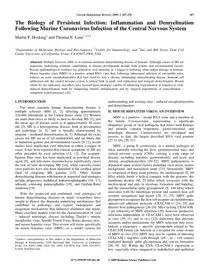
2009 The Biology of Persistent Infection_ Inflammation and Demyelination Following Murine Coronavirus Infection of the C PDF
Preview 2009 The Biology of Persistent Infection_ Inflammation and Demyelination Following Murine Coronavirus Infection of the C
Current Immunology Reviews, 2009, 5, 267-276 267 1573-3955/09 $55.00+.00 © 2009 Bentham Science Publishers Ltd. The Biology of Persistent Infection: Inflammation and Demyelination Following Murine Coronavirus Infection of the Central Nervous System Martin P. Hosking1 and Thomas E. Lane*,1,2,3 1Department of Molecular Biology and Biochemistry, 2Center for Immunology, and 3Sue and Bill Gross Stem Cell Center University of California, Irvine, CA 92697-3900, USA Abstract: Multiple Sclerosis (MS) is an immune-mediated demyelinating disease of humans. Although causes of MS are enigmatic, underlying elements contributing to disease development include both genetic and environmental factors. Recent epidemiological evidence has pointed to viral infection as a trigger to initiating white matter damage in humans. Mouse hepatitis virus (MHV) is a positive strand RNA virus that, following intracranial infection of susceptible mice, induces an acute encephalomyelitis that later resolves into a chronic fulminating demyelinating disease. Immune cell infiltration into the central nervous system is critical both to quell viral replication and instigate demyelination. Recent efforts by our laboratory and others have focused upon strategies capable of enhancing remyelination in response to viral- induced demyelination, both by dampening chronic inflammation and by surgical engraftment of remyelination – competent neural precursor cells. I. INTRODUCTION The most common human demyelinating disease is multiple sclerosis (MS) [1, 2], affecting approximately 226,000 individuals in the United States alone [2]. Women are more than twice as likely as men to develop MS [3], and the mean age of disease onset is at approximately 30 years old [2]. MS is a heterogenous disease, both in presentation and pathology [4, 5], and is broadly characterized by immune – mediated demyelination [6, 7]. Although the exact causes for MS are as of yet unidentified, and are likely due to numerous genetic and environmental factors [8-11], recent studies have implicated viral infection as either a trigger or cause. It has been reported that clinical symptoms of MS are often preceded by viral infection [12, 13]. For example, Epstein Barr virus has been implicated as potential disease agent [8], and infectious mononucleosis significantly raises the risk of later developing MS [14], while varicella-zoster virus particles have also been identified in the cerebral spinal fluid of relapsing MS patients [15]. Other human demyelinating diseases with known or suspected viral etiologies include progressive multifocal leukoencephalopathy [16, 17], subacute sclerosing panencephalitis [18], and Guillain-Barré syndrome [19]. With the suspected and confirmed viral etiologies of human demyelinating diseases in mind, researchers have sought to dissect the disparate underlying mechanisms that contribute to pathology and explore endogenous and exogenous mechanisms that influence resolution and repair. Many excellent models exist for the characterization of viral – induced neurologic disease including Theiler’s murine encephalitis virus, Semliki Forest Virus, Borna disease virus, and mouse hepatitis virus. This review will focus specifically on mouse hepatitis virus (MHV) as a model system for � *Address correspondence to this author at the Department of Molecular Biology & Biochemistry, 3205 McGaugh Hall, University of California, Irvine, CA 92697-3900, USA; Tel: (949) 824-5878; Fax: (949) 824-8551; E-mail:
